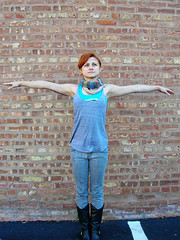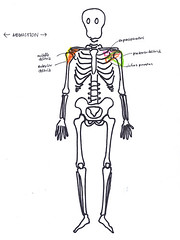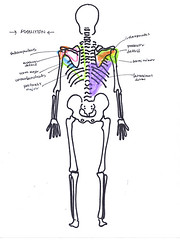Remember ab means from and ad means to, and as long as I brought up planes of movement, abduction and adduction are movements in the frontal plane—i.e., from side to side.
What movements happen at this joint?
So abduction at the shoulder is when you move your arm away from the side of your body, and adduction is when you move it back to the side of your body.
What muscles make these movements happen?
So you can imagine, both anterior and posterior muscles are used to lift and lower your arm out to the side. To keep it from being pulled forward or backward, right? For abduction, it's your anterior deltoid, middle deltoid, and posterior deltoid and also your supraspinatus and infraspinatus on the back side of your shoulder blade. For adduction, it's your anterior deltoid and posterior deltoid again, your subscapularis on the front side of your shoulder blade and your teres minor, teres major, coracobrachialis and the ones that make the most sense to me, your pectoralis major on your chest and latissimus dorsi on your back. I mean, right? Because the muscles that contract to lift the arm would have to be higher, and the muscles that contract to lower the arm would have to be lower?
What exercises make these muscles work?
Where I'm going to get to with this is, you can get at exercising your muscles by exercising your entire range of motion at any particular joint. So here, lateral arm raises would work all the muscles involved in abduction and sdduction.
But I have to learn what the book says for the test, and the book organizes exercises by muscle more than by movement: lateral "butterfly" exercises for deltoids, pushups, pullups, and bench presses for pectoralis major and anterior deltoid, dips and pulldowns for latissimus dorsi and teres major.



